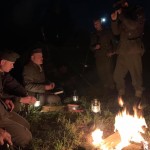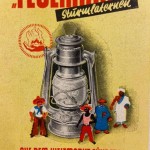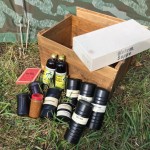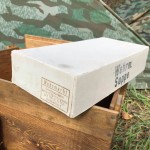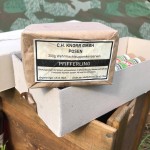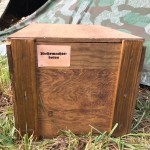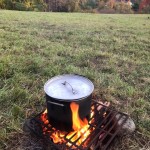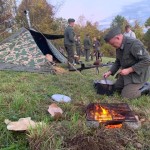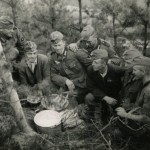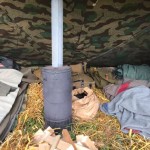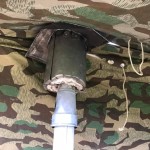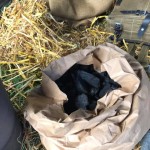My reenactment group attended an event in Haydenville, Massachusetts, in October 2021. I took some photos to illustrate some of the items that we brought to the event, to facilitate a weekend of immersive and realistic activities.
This is my Tornister in the configuration in which I bring it to most events. In the reality of war, in most field situations, the Tornister was kept in the rear with the Kompanie supply train, and was used to contain items that weren’t needed. But there were of course also very many cases where soldiers marched with their packs and had them with them in the field, even in combat settings in some cases. This Tornister is loaded with two blankets- a reproduction of the wartime issue German style, and a surplus WW2 type Italian blanket. There is also, inside, a flashlight, and a Soviet shelter half that I use as a ground sheet (this was an event with an Eastern Front scenario). Inside the pocket under the flap, there is a spare pair of long underwear, a pair of foot wraps and a spare pair of warm knit socks, so important for sleeping in cold temperatures (overnight temperatures at this event were down in the 30s). After arrival at the event, I set up the blankets and ground sheet in our tent where I will sleep, and then use the pack to hold and organize gear that I am not using.
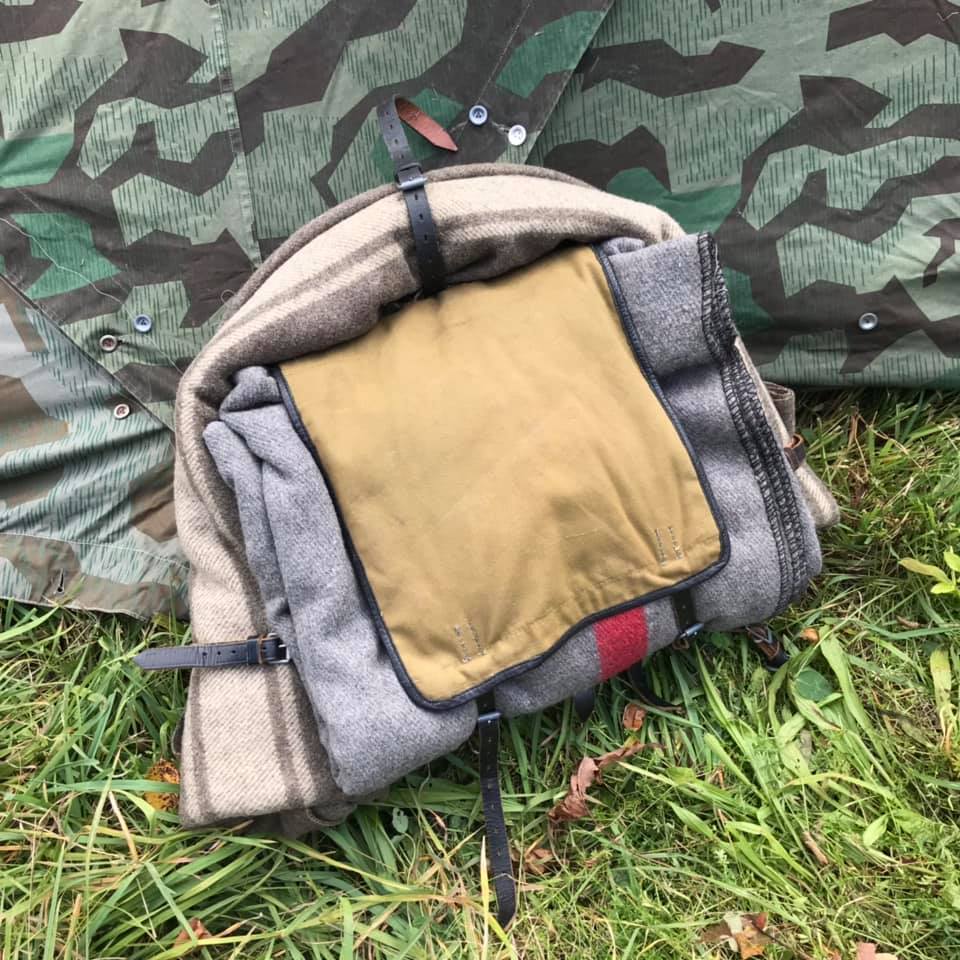
I also brought a lantern and lantern fuel. The lantern is a new made Feuerhand 276. This is a German brand, this model of lantern was introduced in 1934 and the manufacturer did make some lanterns for the Wehrmacht. In the wartime German Army, lanterns like this were not widely used; most issue lanterns were a carbide type rather than these liquid fuel kerosene lanterns. An advantage that these lanterns have today is that the new made ones are widely available and common. I bought this lantern last year, and it was my first; for almost 20 years I re-enacted without one of these, but I can’t imagine going back to not using one. In cold weather, running a lantern like this in a tent all night generates a few degrees of warmth. For gathering firewood at night, for finding one’s way in the dark, these things are ideal and, in my opinion, more practical than period type flashlights. Obviously, a soldier who is marching with only what he can carry is not going to be able to carry a bulky lantern and fuel for it. But in a semi-permanent position, something like this could have been utilized and eventually left behind when it was time to go. I chose this bright green color to be representative of a civilian commercial product rather than a military thing. A collapsed barn is within sight of this camp; the idea that something like this could have been found on a farm is, to me, reasonable. The fuel can is an old brake fluid can that I painted gray with a red cap. This is basically a fantasy thing, but it blends into the background in a camp nicely, and it is certainly a handy thing to have, as we often have more than one lantern going and invariably someone shows up with an empty lantern. Perhaps someday I will buy an actual period kerosene or lamp oil container that I can recreate. In the nighttime photo we are playing the board game “Mensch ärgere Dich nicht” by the light of the moon, a fire, and three lanterns. The advertisement is a wartime era one, showing the same type of lantern I use.
Our unit rations for the event were procured and repackaged by one of our members, Markus Brunner, currently in Germany, and were very generously shipped by him to the US for us to consume at an event. The rations consist of a carefully recreated crate, within which are a mix of reproduced military rations goods and procured/sent from home civil items. These items included canned and dry soup, canned sausages, spreads for bread, as well as liquor, cigarettes and sweets. Normally in our group we prepare meals from fresh bulk foods. This recreation of durable canned and dry rations added a different aspect to our meals, and the attention to detail with regard to the packaging enhanced the realism of the event as well. This supply yielded 2 hearty warm meals for our 8-man team, plus snacks.
This is what we used to cook the unit meals. The big aluminum pot is a type often seen in wartime photos. The smaller blue pot with loop for hanging is also a common style from that era. Blue is one of the enamel colors that I have been able to document being used in prewar Germany for this kind of cookware. The ladle and knife are old civilian things. The grate is from a 100-year-old wood stove. I don’t bring the grate to most events but for this specific setting, a semi-permanent outpost adjacent to a farm, I regarded it as plausible; ordinarily I cook over rocks, or a hole in the ground, but the grate certainly makes it easier. I’ve included some photos of this stuff in use and also a wartime photo from a Sicherung unit showing a cooking pot that is almost identical to the modern aluminum one we use.
We also brought this ZB30. This is a non-firing dummy gun that we use as a prop for immersive scenarios and also (as in this case) for training. In addition to the dummy gun there are also the necessary accessories for those assigned to be the machine gun team: a pistol, Czech MG tool pouch, spare barrel in barrel bag, and the German made box for ZB magazines. Most of our members arrived at the event on Friday, we were able to use Friday afternoon for training on our tactics.
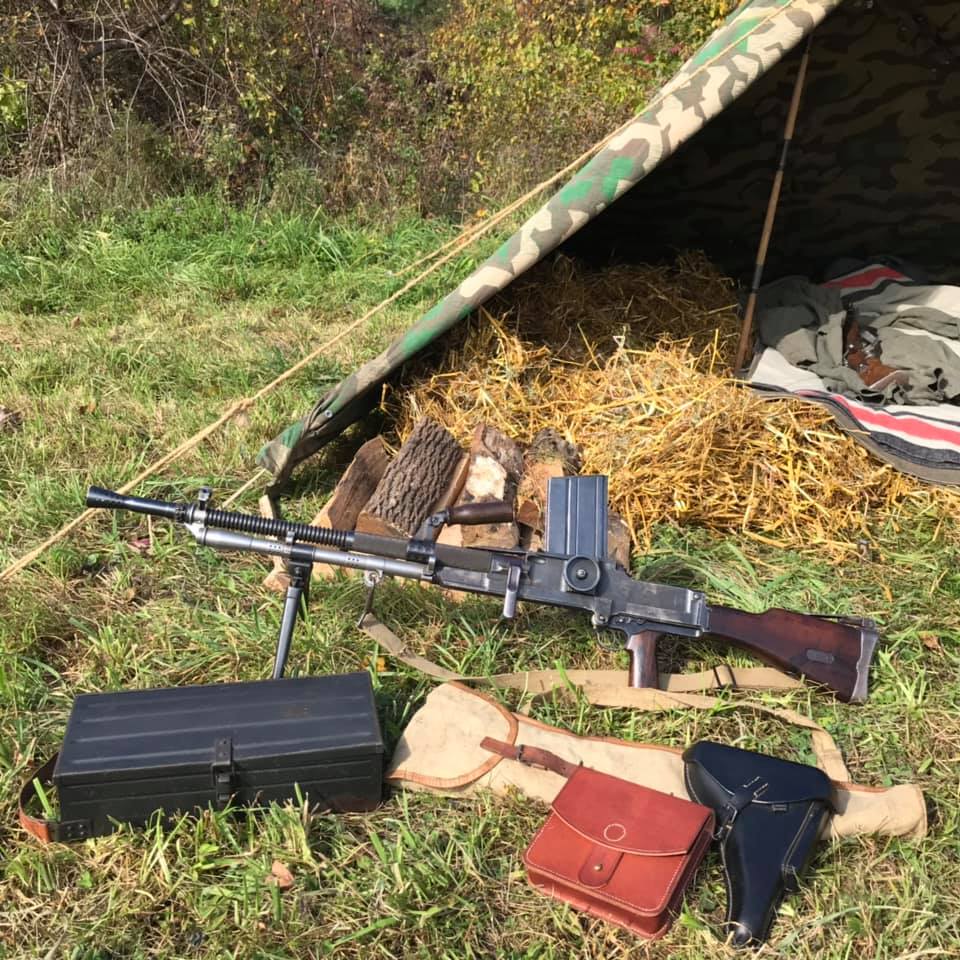
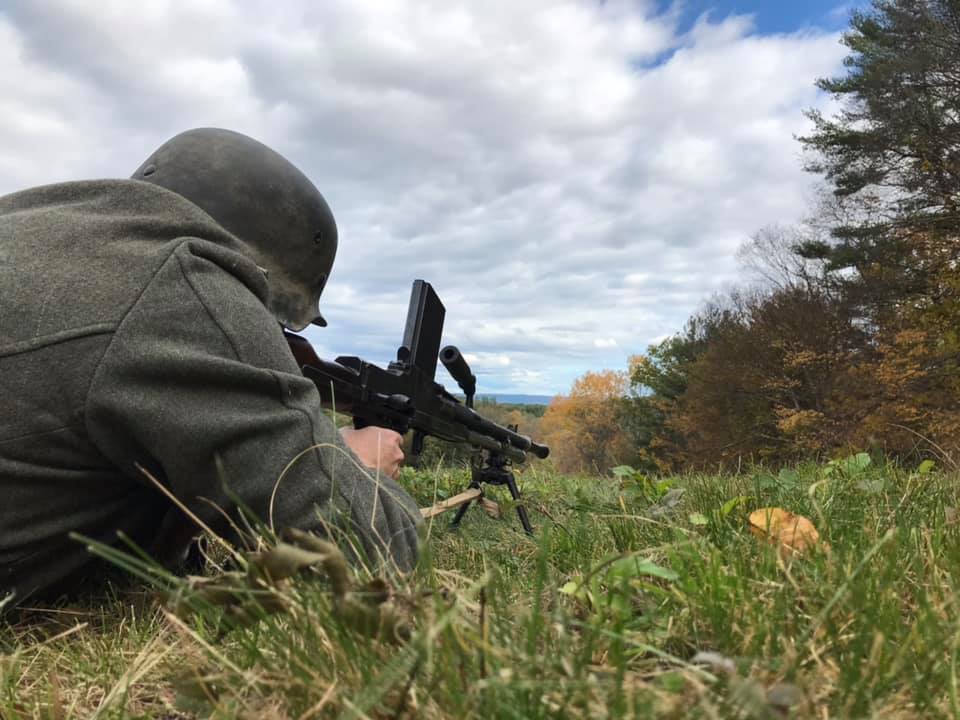
As I mentioned above, temperatures at the reenactment dropped into the low 30s at night. To make sleeping more comfortable, we brought this reproduction field stove. The German manual on winter combat stressed the importance of heated accommodations in cold temperatures, and there are many wartime photos showing various types of stove pipes emerging from tents. This is a sheet metal replica of an issue type stove. We use lump charcoal as fuel, and it throws heat through the night with only minimal need for refueling. There are two key things that reduce the chance of burning down the tent. The first is the insulator and shield where the pipe passes through the opening in the tent. It’s a double wall pipe, with ceramic insulation in the gap, so the metal that touches the tent doesn’t get hot. The other thing is the spark arrestor in the “T” at the top. The smoke exiting the pipe has to flow around a restrictive plate riveted inside this “T.” Sparks hit the plate and fall back into the stove. Saturday night it was nice and cozy in the tent even as a hard frost covered everything outside with a coating of ice.
We also brought these printed training aids. The “Merkblatt” is a something that I made up for our group. It is in English inside, and contains the core of our field tactics and doctrine: how to set up a listening/observation post, information on security patrols, hand and flashlight signals, German language commands and terms we use in the field. The flashlight signals are unique to us, something we made up; most of the rest of what is in there is edited translations from Wehrmacht manuals. The folded green card stock item contains the lyrics to three songs we are working on being able to sing: “Lied der Landesschützen,” “Eine Kompanie Soldaten” and “Wenn Wir Marschieren.” The text is simply printed from my computer, in a period type font, but the cover illustration is a hand done block print.

We also brought our tent, of course. This tent is made of eight reproduction Zeltbahn shelter panels. The zelts are made by different manufacturers (different SMW runs, ATF, different Sturm runs, Trident) to replicate the variation found in originals. The tent pegs are either reproductions of the wartime type or near-identical postwar ones. The poles are reproductions or are similar postwar French and Norwegian surplus. At this event we had people showing up at various times from Friday morning to Saturday morning, leaving Saturday night or Sunday. We had 8 members in attendance but only 6 in the tent. In the reality of war, a unit was in transport together, and they could stop and make tents from each man’s personal shelter quarter/poncho (perhaps supplemented with extra shelter quarters if the situation allowed for it, if the goal was to construct semi-permanent lodging). In reenactment, it doesn’t really work that way. Somebody arriving after dark, to an event in progress, is going to want to have a pre-made, dry, sheltered place to stow his blankets and gear, and for sleeping. There are immersion events where when you arrive at the event you are directed to a fighting position and you man it for the duration regardless of weather. But most events are not like that, and even some events that claim to be that aren’t really that. For most events, having a unit tent for lodging is absolutely crucial.

Every reenactment event is different, with countless variables that need to be taken into account when planning. The items shown here, from personal sleeping gear to the unit tent, are largely applicable to most events. From a logistical standpoint, you need something to sleep on, something to sleep in, and something to sleep under; it’s nice to have illumination at night, and meals to eat, when the event is not providing them. Training aids provide opportunity for realistic activity, and prevent people from getting restless and bored. Heated accommodations make a tremendous difference for modern humans who are not acclimated to sleeping outdoors. Being a member of a reenactment group means being part of a team who can share these logistical burdens.

